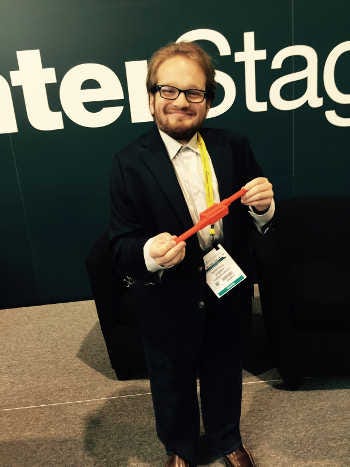Teenage Inventor Is Making a Novel Spinal Implant
May 8, 2015
Harry Paul, a freshman at Tufts University who has developed a scoliosis device, had some words of wisdom for medical device developers at BIOMEDevice Boston.
Brian Buntz
|
Harry Paul shows off one of the many prototypes for his device at BIOMEDevice Boston. |
Harry Paul spent three years in high school working on a spinal implant, eventually partnering with the K2M Group (Leesburg, VA) to refine its design and file a patent for it.
Born with a congenital form of scoliosis, Paul underwent 16 spinal surgeries by the age of 11. "Patients with congenital scoliosis often need surgery every three to six months," he said in a session at BIOMEDevice Boston that covered the intersection of the Maker movement and medtech.
To help prevent others from having to undergo such an extensive number of surgeries, Paul came up with the idea for a titanium-alloy spinal implant that gradually expands, correcting abnormal curvature as the patient grows.
Paul recently was invited to display the device at the White House Science Fair.
He has already won several awards from the idea, too, including first place in the materials and bioengineering category at the 2014 Intel International Science and Engineering Fair and the Innovation Exploration Award. He also won a $10,000 scholarship from the U.S. Office of Naval Research.
The young inventor recommends striking a balance between the unbridled optimism and go-getter attitude of the mainstream Maker DIY movement and the careful thought inherent in medical device engineering.
Paul states that when he first started developing the device, he wanted to single handedly develop blueprints for a novel spinal implant. "I was naive in the beginning. When I started, I didn't want to listen to anybody about tolerances. I wanted to design the devices that were in my head and I was doing this from 5 a.m. in my room," he said. "I didn't have a team. I didn't have anyone to certify my drawings before going to production."
His eventual partnership with engineers and the experience of working on patent drawing forced him to develop an appreciation for the traditional design process. "I learned so much from having to redo my work [for the patent application process] that it has informed my design process in a really positive way."
After working on the invention for three and a half years, collaborating with a device firm, and doing exhaustive testing, Paul is still confident about the device's potential. "I proved it did what I wanted it to," he explained.
Still, he initially wouldn't have expected the development of a device, which will be a PMA product, would take so long to be commercialized. "It will be five to 10 years to see how long it will take to be used, and there are good reasons for that. Medical devices can be some of the most dangerous things in medicine."
It's understandable, too, why many ideas for groundbreaking devices never make it past the proverbial napkin stage. "There are lots of stories about people who started out [designing a new technology] and as soon as it got out there, it was shut down by people scared of change."
There needs to be a better balance between the nothing-is-impossible attitude of the Maker movement and the risk aversion inherent in medical device development, Paul said. "Whether you are a senior engineer for a local firm or a high school inventor, this discourse still could use some work."
It is important to not let any product development challenges that pop up from diminishing the desire to create groundbreaking clinically relevant products, he stressed.
When asked what he plans on doing after he finishes up his degree in biomedical engineering, he said: "Whether I decide to apply to medical school or continue with engineering, I am not sure. But wherever I end up, I want to have the same culture of optimism that I had in working with this."
Refresh your medical device industry knowledge at MD&M East in New York City, June 9-11, 2015. |
Brian Buntz is the editor-in-chief of MPMN and Qmed. Follow him on Twitter at @brian_buntz.
Like what you're reading? Subscribe to our daily e-newsletter.
About the Author(s)
You May Also Like



